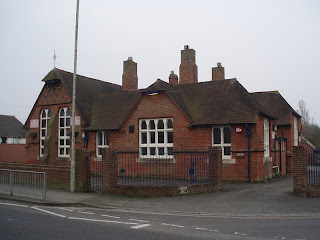Mary Castle, a first cousin of my great grandfather, got married in 1865, the same year her new husband Edmund Daubeny began a living as rector of St Thomas’s, then a country church in the village of Bedhampton near Havant in Hampshire. They married in Bedminster – no connection at all to Bedhampton but a rapidly expanding industrial suburb of Bristol.
Church of St Thomas the Apostle, Bedhampton
served by Rev E.T. Daubeny for 19 years, 1865-1884
(photographed in 2007 by M. Eyre)
The Castles and the Daubenys were both old Somerset families who migrated to the city of Bristol in search of wealth and power. The Castles were particularly successful, supplying the town with councillors, sheriffs and two mayors and making a fortune in the distillation of spirits, part of the Triangular Trade on which Bristol was built.
It was natural when Mary got married that they would wish to bestow some of that wealth on their new son in law. His new church had been built in 1140 – a Norman arch survives at the western end of the chancel – and Edmund followed contemporary thinking in deciding that it was long overdue for a makeover. There were undoubted limitations to the old building. It lacked a vestry for a start, although it did have a beautiful Georgian rectory ten yards away across the lane which no doubt fulfilled the function more than adequately.
St Thomas before the vestry extension of 1993,
showing the Castle vestry, bell tower and north aisle
Between 1869 and 1878 Edmund undertook a series of improvements. As well as adding a small vestry to the north of the chancel and replacing the wooden bell tower with a stone one, he increased the capacity of the nave with new pews and a fine north aisle. All these building works were undertaken with generous donations from the Castle family back in Bristol. At the same time he found in the garden of the rectory the remains of the Norman font, in use I suspect as a Victorian planter. This was restored and replaced in the church, where it now serves its original function once more.
Perhaps the biggest outward change introduced by Edmund was a change in the church’s dedication. It had been known since at least the 16th century as St Nicholas, and in 1869 it was renamed St Thomas in deference, I imagine, to Thomas Castle the principle subscriber to the works. Thomas was Edmund’s brother in law, Mary’s half-brother by their father’s first marriage. He was probably giving money recently inherited from their father, who died just a year after Mary and Edmund’s marriage.
Old Bedhampton School
a place of Dust, Stone and Daubeny
according to the logbook
(photographed in 2007 by M. Eyre)
Although presumably life as a country rector was not too demanding, Edmund Daubeny was obviously an active incumbent, determined to leave his mark on his church and his community. The year before he began his program of works on the fabric of the church, the first ever school in Bedhampton opened its doors, under the tutelage of the splendidly named Miss Dust. According to the early school ledgers, both the village squire (the equally splendidly named Mr Stone) and the rector were regular visitors to the school and took a keen interest in her work.
(photo by permission of www.bedhamptonparish.org.uk
from whom much fascinating detail informs this article)
from whom much fascinating detail informs this article)









No comments:
Post a Comment